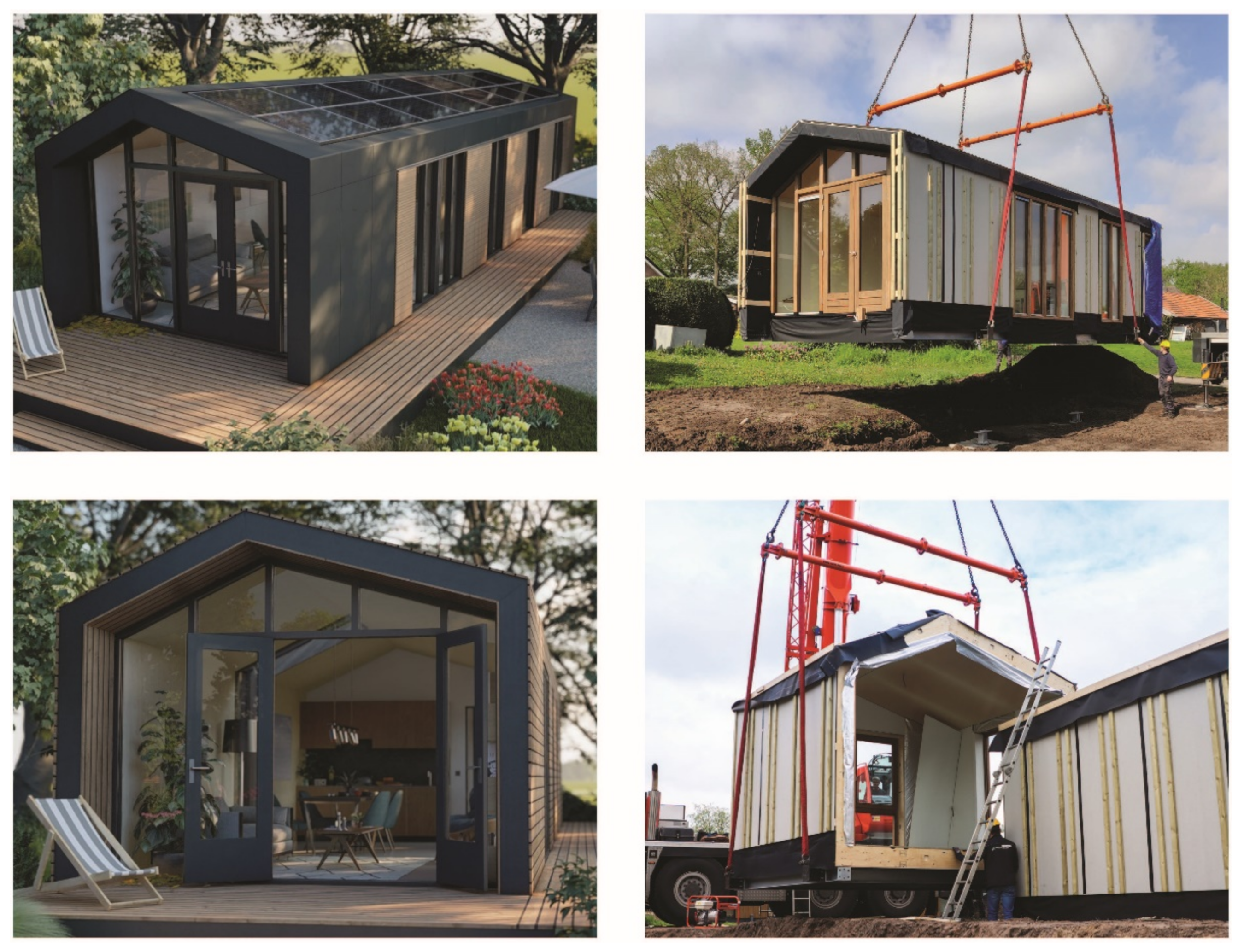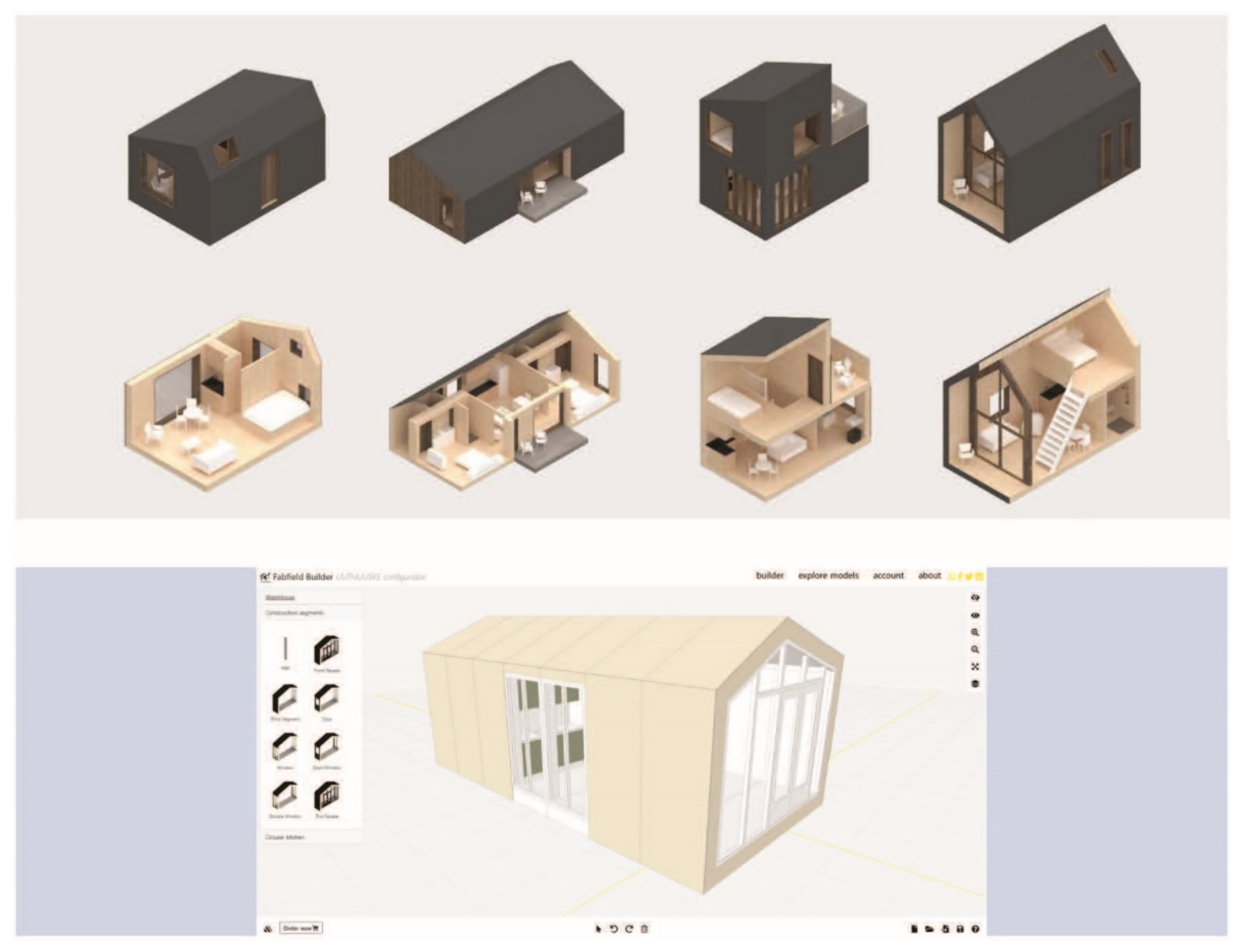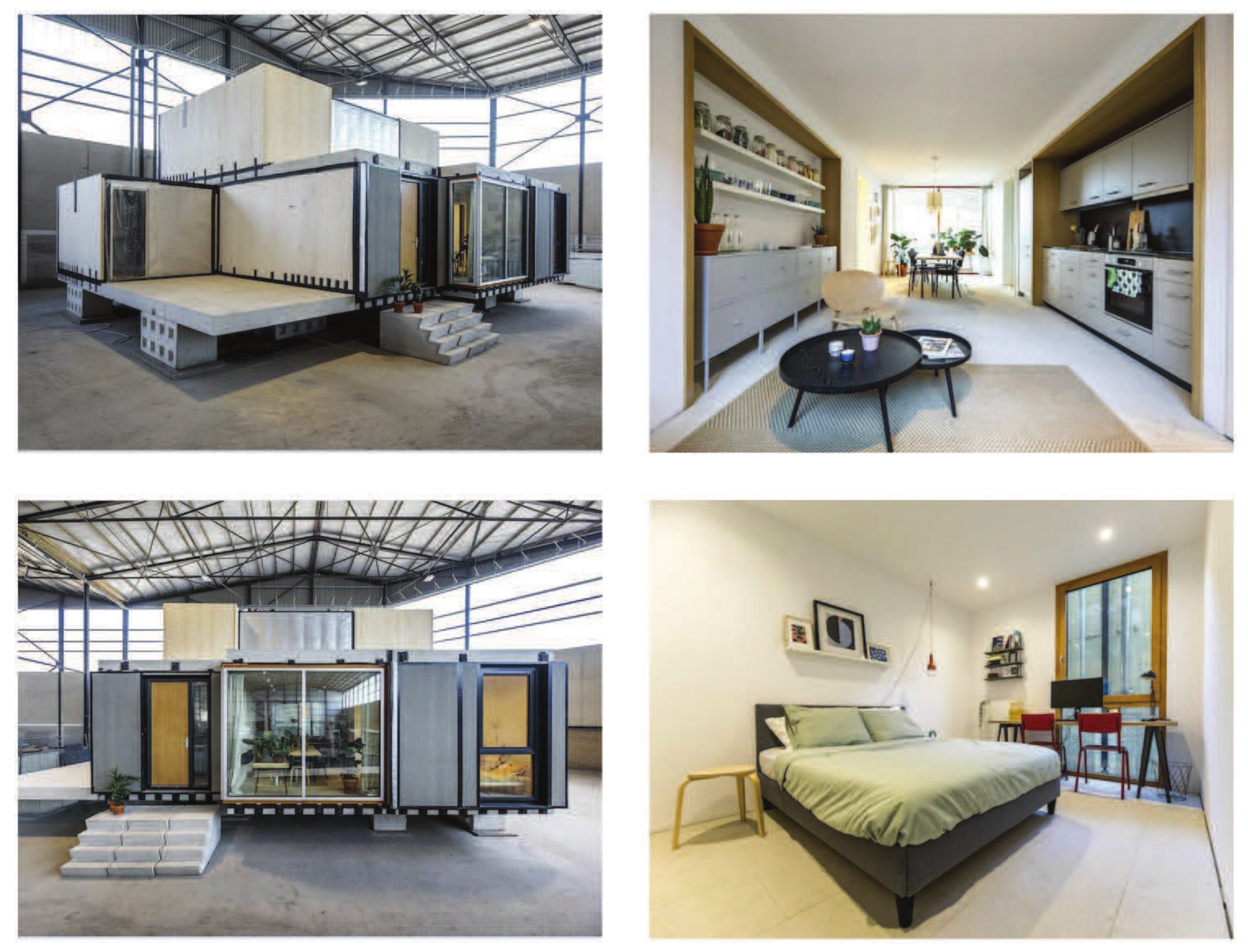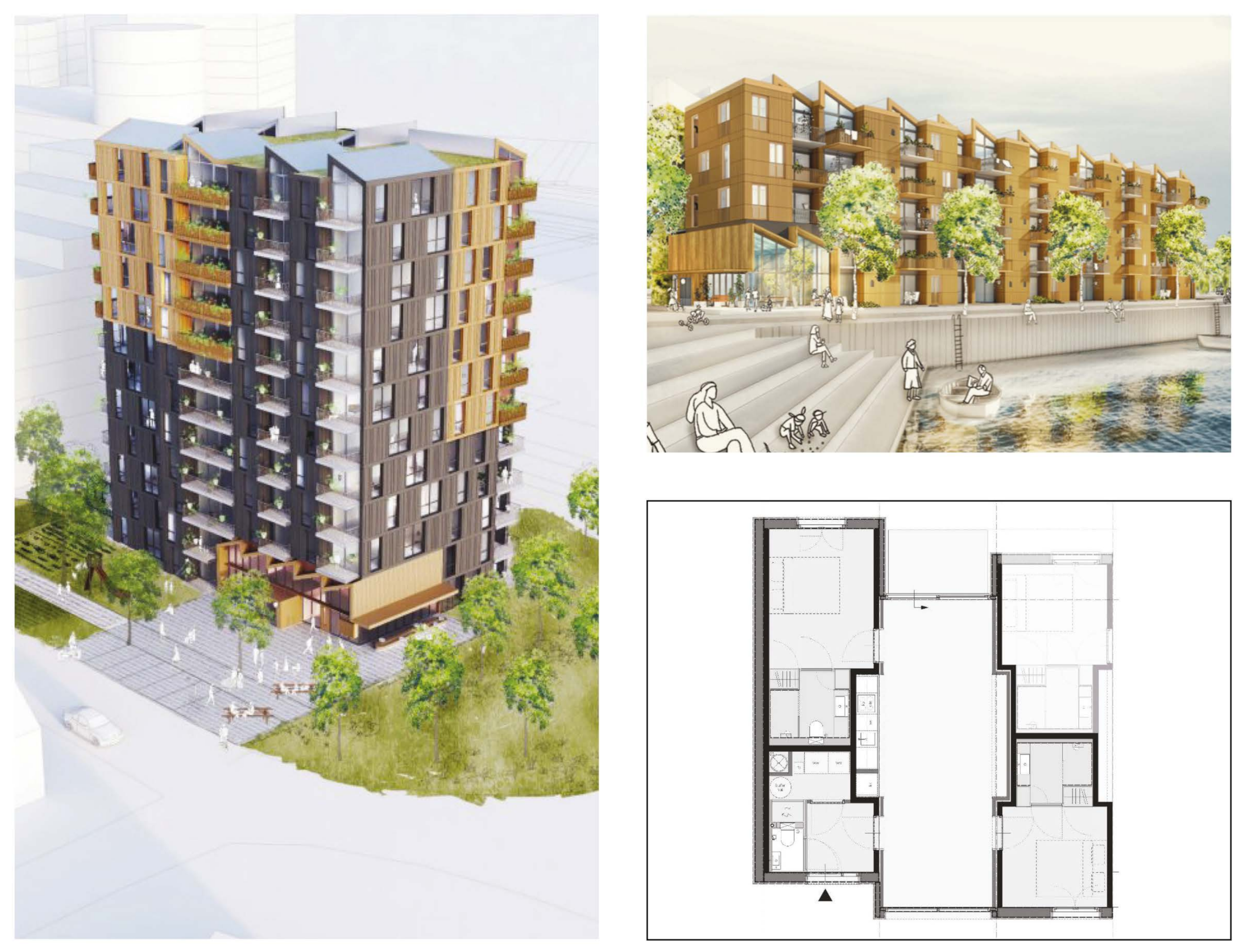New Housing Concepts: Modular, Circular, Biobased, Reproducible, and Affordable
Abstract
:1. Introduction: Affordable Housing through a Continuous Stream of Assignments
2. Definitions, Terms, Method, and Challenge
2.1. What Is a Dwelling According to Dutch Housing Associations?
2.2. Terms and Definitions
2.3. Research through Design (RTD) as Methode
2.4. The Candidates for the Challenge
3. Innovative Building Concepts Turn out to Be Modularly Produced
3.1. Uuthuuske-the New Makers
3.2. MOOS-in the Middle of Our Street
3.3. Living Outside the Lines-Dura Vermeer
4. What Are the Characteristics of Modular Building Systems?
4.1. Design and Construction Supply Chain Management
4.2. Architecture without a Spatial Context
4.3. Mass Production with Freedom of Choice
4.4. Smart Core with Kitchen, Bathroom, Toilet, Service System
4.5. Hybrid Building Structure in Stacked Construction
4.6. Sustainable Performance of the Modules
5. Discussion of Results and Dilemmas
5.1. Carbon Neutral Energy Use versus Environmental Impact Materials
5.2. Total-Cost-of-Ownership Is Not Standardized and Not Comparable
5.3. The Land Costs and Availability of Plots in Urban Regions Are a Problem
5.4. Recognition of a New Residential Culture Is Lacking in ‘De Woonstadaard’
6. Conclusions and Next Steps
Author Contributions
Funding
Institutional Review Board Statement
Informed Consent Statement
Data Availability Statement
Acknowledgments
Conflicts of Interest
References
- So You Think You Can BUILD?—ESTI. Available online: https://www.esti.site/soyouthinkyoucanbuild/ (accessed on 20 July 2021).
- Nationale Omgevingsvisie, Duurzaam Perspectief Voor Onze Leefomgeving. 2020. Available online: https://denationaleomgevingsvisie.nl/publicaties/ (accessed on 20 July 2021).
- Oorschot, L. Nederland Kantelpunt—Peter Boelhouwer: Interview over 20 Jaar Woningmarkt in Nederland. 2021. Available online: https://research.tudelft.nl/en/publications/nederland-kantelpunt-peter-boelhouwer-interview-over-20-jaar-woni (accessed on 20 July 2021).
- Samen Werken Aan Goed Wonen. Actieagenda Wonen—17 Februari 2021. Available online: https://aedescms.getbynder.com/m/40d9069ce1416bc6/original/Actieagenda-Wonen.pdf (accessed on 20 July 2021).
- Netwerk Conceptueel Bouwen NCB. Available online: https://www.conceptueelbouwen.nl/ (accessed on 20 July 2021).
- Aedes. Available online: https://www.aedes.nl/ (accessed on 20 July 2021).
- Aedes & NCB. Programma de Bouwstroom. Sneller en meer Betaalbare Huizen Bouwen. 2020. Available online: https://dkvwg750av2j6.cloudfront.net/m/28444d436a5adb22/original/Brochure-Programma-De-Bouwstroom-Aedes-en-Netwerk-Conceptueel-Bouwen-maart-2020.pdf (accessed on 20 July 2021).
- NCB. De Woonstandaard. Available online: https://www.conceptueelbouwen.nl/dewoonstandaard (accessed on 20 July 2021).
- NCB. De Conceptenboulevard. Available online: https://www.conceptenboulevard.nl/ (accessed on 20 July 2021).
- De Bouwstroom. Available online: https://www.debouwstroom.nl/ (accessed on 20 July 2021).
- Webinar Bouwstroom 1 Oktober 2020. Available online: https://www.tudelft.nl/bk/over-faculteit/afdelingen/management-in-the-built-environment/organisatie/leerstoelen/publiek-opdrachtgeverschap-in-de-bouw/webinars/webinar-bouwstroom-1-oktober-2020 (accessed on 20 July 2021).
- Cooplink Kennisnetwerk Wooncoöperaties. Available online: https://www.cooplink.nl/wiki/Woningwaarderingsstelsel_(WWS) (accessed on 20 July 2021).
- Woordenboek Circulaire Economie. Available online: https://www.cewoordenboek.nl (accessed on 20 July 2021).
- Lexicon Circular Construction Unambiguous Terms and Definitions. 2020. Available online: https://platformcb23.nl/images/downloads/PlatformCB23_Lexicon_Circular_Construction_2.0.pdf (accessed on 20 July 2021).
- Yin, R. Case Study Research: Design and Methods; Applied Social Research Methods Series; SAGE Publications: Thousand Oaks, CA, USA, 1994; Volume 5. [Google Scholar]
- Groat, L.; Wang, D. Architectural Research Methods; John Wiley & Sons: Hoboken, NJ, USA, 2002; Available online: https://nexosarquisucr.files.wordpress.com/2016/03/architecturalresearchmethods-groat_wang.pdf (accessed on 20 July 2021).
- Godin, D.; Zahedi, M. Aspects of Research through Design: A Literature Review. In DRS 2014: Design’s Big Debates—Proceedings of Design Research Society Conference; Lim, Y.-K., Niedderer, K., Redström, J., Stolterman, J., Valtonen, A., Eds.; Umeå Institute of Design: Umeå, Sweden, 2014; pp. 1667–1679. Available online: https://dl.designresearchsociety.org/cgi/viewcontent.cgi?article=1012&context=conference-volumes (accessed on 20 July 2021).
- Jonker, M. Goedkoope Arbeiderswoningen (1936); Van Gennep: Amsterdam, The Netherlands, 1981. [Google Scholar]
- Dorsman, E.; Gameren, D.; Kuitenbrouwer, P.; Schweigman, J.; Verdonk, N. Intense Laagbouw. Woningbouw in Hoge Dichtheden; Platform GRAS: Groningen, The Netherlands, 2009. [Google Scholar]
- Berlage, H.P.; Keppler, A.; Kormhout, W.; Wils, J. Arbeiderswoningen in Nederland; W.L.& J. Brusse’s uitgevermaatschappij Rotterdam: Rotterdam, The Netherlands, 1921. [Google Scholar]
- Conceptaanbieders. Available online: https://conceptenboulevard.nl/aanbieders (accessed on 20 July 2021).
- Pitch of the Candidates. Available online: https://www.conceptueelbouwen.nl/post/bekijk-de-video-s-van-de-finalisten-so-you-think-you-can-build-challenge (accessed on 20 July 2021).
- The New Makers. Available online: https://thenewmakers.com/product/uuthuuske/ (accessed on 20 July 2021).
- Comfort Cabin. Available online: https://thenewmakers.com/product/comfort-cabin/ (accessed on 20 July 2021).
- In the Middle of Our Street. Available online: https://inthemiddleofourstreet.nl/ (accessed on 20 July 2021).
- Leven Buiten de Lijntjes. Available online: https://www.duravermeer.nl/levenbuitendelijntjes/ (accessed on 20 July 2021).
- Wamelink, H.; Industriële Woningproductie Ontstaat Niet Vanzelf. PowerPoint Presentation. 2020. Available online: https://d2k0ddhflgrk1i.cloudfront.net/BK/Over_de_faculteit/Afdelingen/Management_in_the_Built_Environment/Praktijkleerstoelen/Publiek_opdrachtgeverschap/bijeenkomsten/Webinar%20Renovatieversneller%20juni%202020/Presentatie%20Wamelink%20Webinar%20Bouwstroom%201%20oktober%202020.pdf (accessed on 20 July 2021).
- Oorschot, L. De Apostel van de Verdichtingskerk Rijksbouwmeester Floris Alkemade en de Weilandvolbouwer en Woningbouwhoogleraar Peter Boelhouwer in Debat over de Woningopgave. 2020. Available online: https://research.tudelft.nl/en/publications/de-apostel-van-de-verdichtingskerk-rijksbouwmeester-floris-alkema (accessed on 20 July 2021).
- Passive House. Available online: https://passiefbouwen.nl/&https://passivehouse.com/&https://www.phius.org/ (accessed on 20 July 2021).
- Lente Akkoord Zeer Energiezuinige Nieuwbouw. Available online: https://www.lente-akkoord.nl/ (accessed on 20 July 2021).
- Niyongabo-Paulussen, E.; Nuiten, P.; Cornelisse, M.; Valk, H. Scherpere eis Voor BENG 1 Heeft Wisselend Effecten. 2021. Available online: https://www.lente-akkoord.nl/scherpere-eis-voor-beng-1-heeft-wisselende-effecten/ (accessed on 20 July 2021).
- Elkington, J. Towards the Sustainable Corporation: Win-Win-Win Business Strategies for Sustainable Development. Calif. Manag. Rev. 1994, 36, 90–100. [Google Scholar] [CrossRef]
- Nuiten, P. (16 February 2018) Pieter Nuiten (W/E Adviseurs) over Grenswaarde MPG. Available online: https://www.lente-akkoord.nl/pieter-nuiten-w-e-adviseurs-over-strengere-grenswaarde-mpg/ (accessed on 20 July 2021).
- GPR. Available online: https://www.gprsoftware.nl (accessed on 20 July 2021).
- Sociale Verhuurders Haaglanden. Ruim 79000 Woningen Extra en Betere Verdeling in Regio Haaglanden. Available online: https://www.socialeverhuurdershaaglanden.nl/bouwmee-2/ (accessed on 20 July 2021).
- Ten Teije, S. Bekende Woningbouwer Neemt Langzaam Afscheid van Beton en staal. Newspaper AD. 18-11-2021. Available online: https://www.ad.nl/wonen/bekende-woningbouwer-neemt-langzaam-afscheid-van-beton-en-staal~ab1b7537/ (accessed on 20 July 2021).
- Convenant Green Deal Houtbouw. Available online: https://www.metropoolregioamsterdam.nl/wp-content/uploads/2021/10/Convenant-Green-Deal-Houtbouw.pdf (accessed on 20 July 2021).









Publisher’s Note: MDPI stays neutral with regard to jurisdictional claims in published maps and institutional affiliations. |
© 2021 by the authors. Licensee MDPI, Basel, Switzerland. This article is an open access article distributed under the terms and conditions of the Creative Commons Attribution (CC BY) license (https://creativecommons.org/licenses/by/4.0/).
Share and Cite
Oorschot, L.; Asselbergs, T. New Housing Concepts: Modular, Circular, Biobased, Reproducible, and Affordable. Sustainability 2021, 13, 13772. https://doi.org/10.3390/su132413772
Oorschot L, Asselbergs T. New Housing Concepts: Modular, Circular, Biobased, Reproducible, and Affordable. Sustainability. 2021; 13(24):13772. https://doi.org/10.3390/su132413772
Chicago/Turabian StyleOorschot, Leo, and Thijs Asselbergs. 2021. "New Housing Concepts: Modular, Circular, Biobased, Reproducible, and Affordable" Sustainability 13, no. 24: 13772. https://doi.org/10.3390/su132413772





